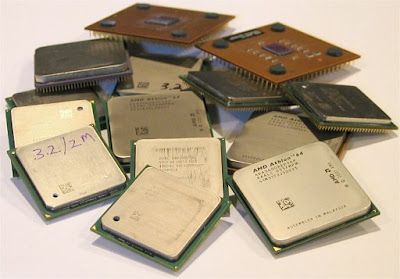Most modern motherboards automatically read the CPU and memory components to determine their
proper speed, timing, and voltage settings. Originally, these settings were controlled by jumpers and
switches, but in most modern boards you can enter the BIOS Setup to change these settings to manual
and then use the menu options in the BIOS Setup to alter the speed of the system. Because such
alterations can make the system unstable, most systems are designed to boot into the BIOS Setup at a
default low speed so you are not locked out from making changes in the future. This makes
overclocking as simple as changing a few menu options and then rebooting to test the selections
you’ve made.
The concept for overclocking is simple: You change the settings to increase the speed of the
processor, memory, buses, and so on, until the system becomes unstable. Then you can go back in and reduce the settings until the system is stable again. In this manner, you find the maximum sustainable speed for a system. Because each processor is different, even ones with the same ratings can end up allowing different maximum stable speeds.
Why can some chips be clocked faster than others? The reason is in how they are manufactured and
marked. As an example, the first Pentium 4 chips based on the Prescott core used die that were 112
square mm on 300mm wafers, resulting in a maximum of 529 full die per wafer. Due to defects, many of those die wouldn’t work, but let’s say that 423 (about an 80% yield) were good. Intel initially sold the Prescott core processors at speeds from 2.4GHz through 3.4GHz, which meant that all the die on each wafer were designed to potentially run at the highest rated speed. However, out of the good (working) die, testing would show that although some of those would indeed run at the highest 3.4GHz rated speed, others would work reliably only at lower speeds. The finished chips would have been sorted into bins according to their speed test results.
Early in manufacturing a given processor design, the sorted bins of chips at the end of the line would
contain more that passed only the lower speed tests, and fewer that ran at the highest speeds. This is
why the fastest chips are the most expensive—generally fewer of the chips produced on a given day
will pass the testing at that speed. Eventually, however, as the manufacturing processes and chip
design are tweaked, more and more of the finished chips end up passing the higher-speed tests. But
because lower-speed chips are priced less and sell more, the manufacturer might have to dip into the
faster bins and mark those chips at the lower speeds to fill the larger number of orders.
Essentially what I’m saying is that chipmakers such as Intel and AMD make all the chips on a wafer
identically and try to make them so they will all run at the highest speeds. If you purchase one of the
lesser-rated chips, you really have the same chip (die) as the higher-rated versions; the difference is
the higher-rated ones are guaranteed to run at the higher speeds, whereas the lower-rated ones are not.
That is where overclockers come in.
Tip
The current speed of a processor might not be its actual rated speed, either because of
overclocking or because some recent systems reduce processor speed when the system is not
heavily tasked. Both Intel and AMD have developed software tools that can properly identify
the rated speed of a processor.
For newer Intel processors, use the Intel Processor Identification Utility; for older chips, use
the Intel Processor Frequency ID Utility. Both of these are available from
For AMD processors, use either the AMD CPU Info program or the AMD Clock program. To
find these, visit http://support.amd.com, select Drivers and Downloads, All Processors. Then
search for CPU info and AMD Clock.
One drawback of the Intel and AMD programs is that they only work on their respective brands
of chips. Another excellent utility that works on both Intel and AMD processors is the CPU-Z
program available from www.cpuid.com. I routinely install this program on any systems I
build or service because it provides universal processor (and chipset) identification.
Users who overclock their systems purchase chips rated at lower speeds and essentially do their own
testing to see if they will run at higher speeds. They can also start with the highest-rated chips and see
whether they can run them even faster, but success there is much more limited. The most successful
overclocking is almost always with the lowest-rated speed of a given design, and those chips are also
sold for the lowest price. In other words, statistically you might be able to find many of the lowest speed grade chips that are capable of running at the highest-speed grade (because they are essentially
identical during manufacture); however, if you start with the highest-speed grade, you might be able
to increase the speed only a small percentage.
Just remember that a difference exists between the rated speed of a chip and the actual maximum
speed at which it runs. Manufacturers such as Intel and AMD have to be conservative when they rate
chips, so a chip of a given rating is almost always capable of running at least some margin of speed
faster than the rating—the question is, how much faster? Unfortunately, the only way to know that is
by trying it out—that is, by testing chips individually.
Unlocking Cores
A variation of overclocking is the unlocking of disabled cores on AMD Phenom II and Athlon II
processors for better performance in single-threaded and multithreaded applications and when
multitasking. Many of AMD’s X3 and X2 K10-based processors are based
on X4 designs that have one or two cores disabled.
If you unlock these cores using a method such as enabling the Advanced Clock Calibration (ACC)
feature in the system BIOS (see www.tomshardware.com/reviews/unlock-phenom-ii,2273-5.html for
details), one of the following results can take place:
• The unlocked core may function perfectly. This is the result if a core were disabled strictly to
enable the chip to be sold as an X3 rather than an X4.
• Your system boots and runs normally, but the “unlocked” core can’t be detected or used. A core
disabled because of moderate problems would result in this problem.
• Your system might not boot or might not be able to run Windows until you reset the ACC setting
in your system BIOS to its default mode. More serious core stability problems would cause this
result.
• You could destroy your processor or motherboard. This would be the result if the core were
disabled because it contained a short.
To be able to try unlocking disabled cores, you need a motherboard that has an adjustable ACC
setting in the system BIOS (many motherboards using the AMD750 South Bridge [SB] feature this
option) and a motherboard BIOS that does not include AMD-provided microcode to prevent
unlocking via the ACC adjustment routine.
Although the AMD850 South Bridge used on the latest motherboards does not include an ACC option, motherboard vendors such as ASUS and Gigabyte have added an ACC chip to their motherboards and added core unlocking capabilities to their BIOS setups. MSI also offers unlocking but is using a purely BIOS-based unlock routine for its motherboards with the SB850 processor.
If you do unlock an additional core or two, you might enjoy faster performance and better
multithreaded and multitasking operating for free, or you might find your system to be unstable or
unable to start. Before you assume that a system that runs with an unlocked core is truly stable, use
, “PC Diagnostics, Testing, and Maintenance.”
Note
The latest four-core and six-core FX processors from AMD cannot have their additional cores
unlocked because the leads have been cut during production.




























No comments:
Post a Comment